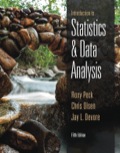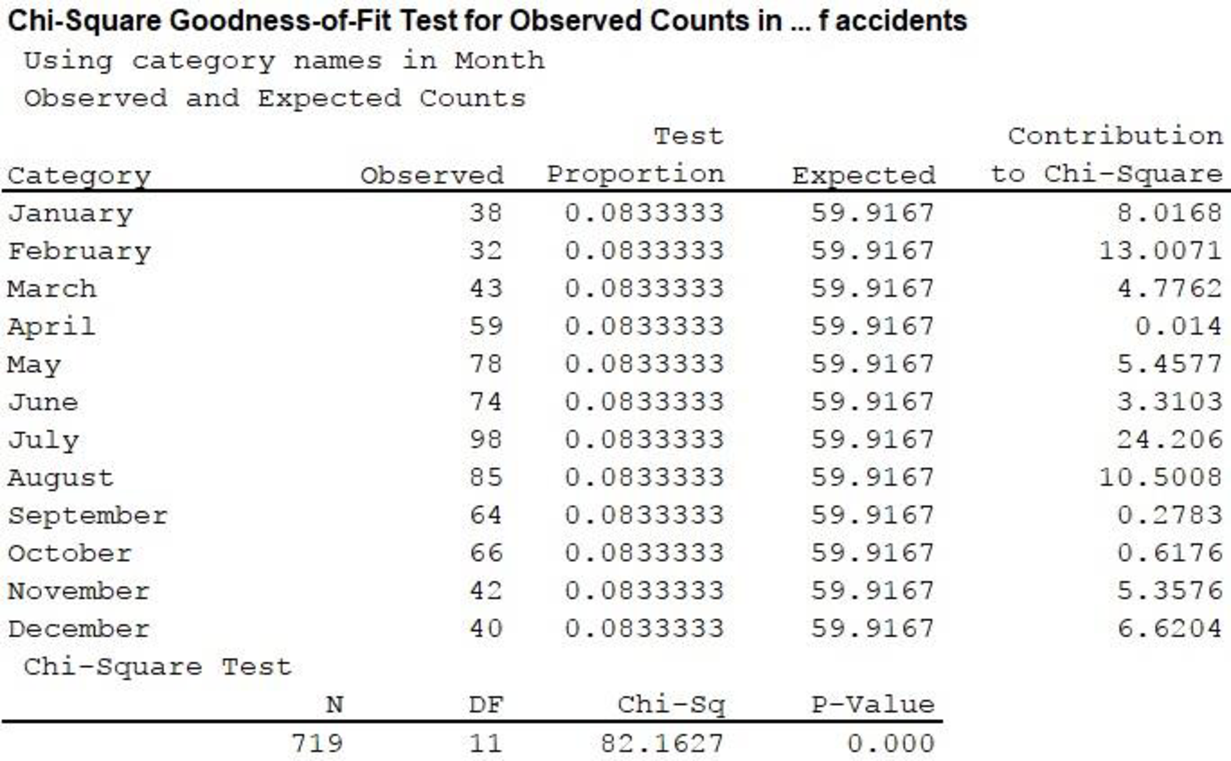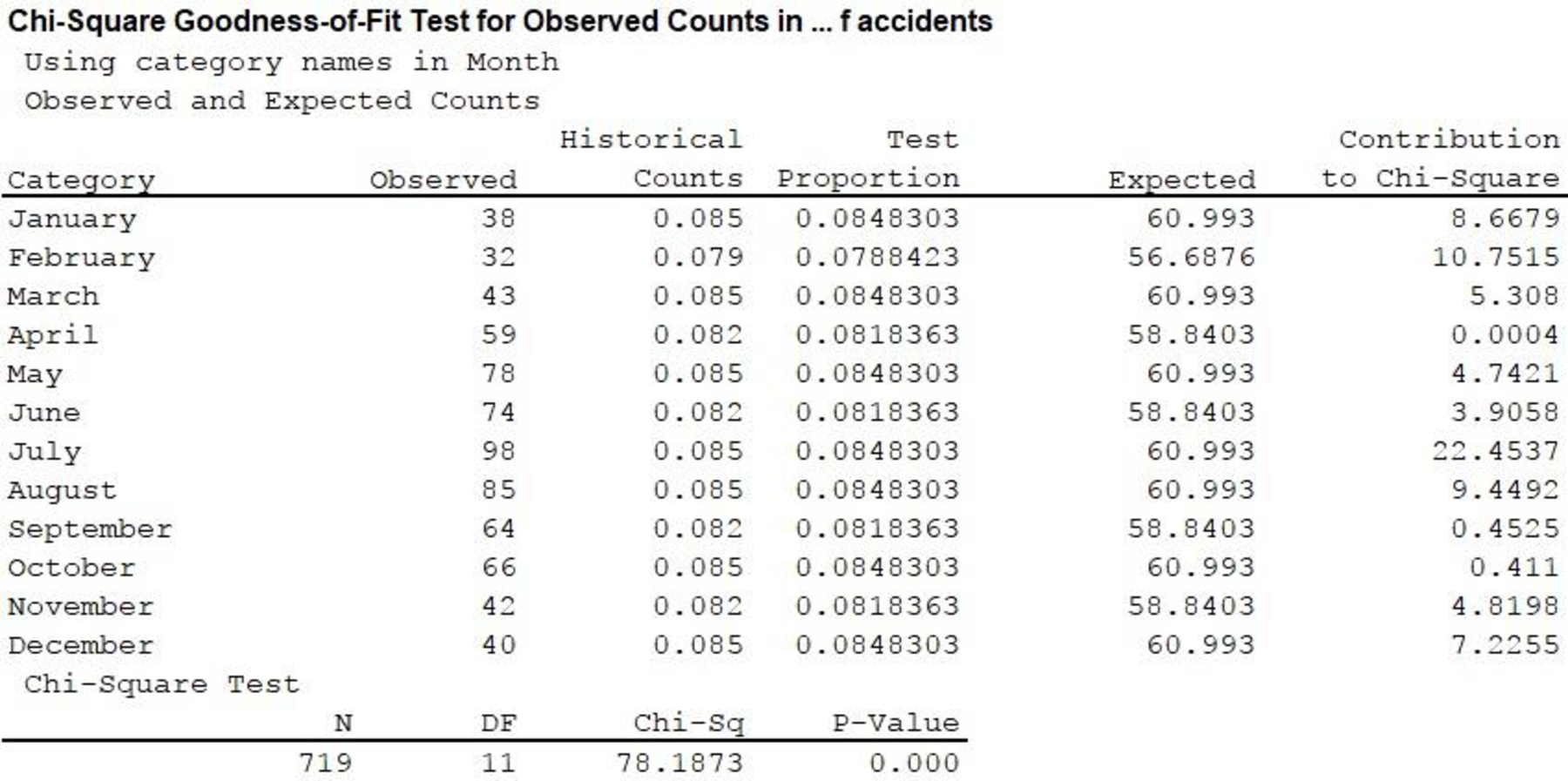
a.
Test whether fatal bicycle accidents are equally likely to occur in each of the 12-months at 0.01 significance level.
a.
Answer to Problem 10E
There is convincing evidence that fatal bicycle accidents are not equally likely to occur in each of the months.
Explanation of Solution
Calculation:
The given data represent the classification of fatal bicycle accidents according to the month in which the accident occurred.
The expected counts are calculated as shown below:
| Month | Observed counts | Expected counts |
| January | 38 | |
| February | 32 | |
| March | 43 | |
| April | 59 | |
| May | 78 | |
| June | 74 | |
| July | 98 | |
| August | 85 | |
| September | 64 | |
| October | 66 | |
| November | 42 | |
| December | 40 | |
| 719 | 719 |
The nine-step hypotheses testing procedure to test goodness-of-fit is given below:
1. Consider that the proportion of fatal bicycle accidents occurring in January is
2. Null hypothesis:
3. Alternative hypothesis:
4. Significance level:
5. Test statistic:
6. Assumptions:
- Assume that the 719 accidents included in the study is a random sample from the population of fatal bicycle accidents.
- From the table, it is observed that all the expected counts are greater than 5.
7. Calculation:
Software procedure:
Step-by-step procedure to obtain the test statistics and P-value using the MINITAB software:
- Choose Stat > Tables > Chi-Square Goodness-of-Fit Test (One Variable).
- In Observed counts, enter the column of Number of Accidents.
- In Category names, enter the column of Month.
- Under Test, select the Equal Proportions.
- Click OK.
The output obtained using the MINITAB software is given below:

From the output,
8. P-value:
From the MINITAB output,
9. Conclusion:
Decision rule:
- If P-value is less than or equal to the level of significance, reject the null hypothesis.
- Otherwise, do not reject the null hypothesis.
Conclusion:
Here the level of significance is 0.01.
Here, P-value is less than the level of significance.
That is,
Hence, reject the null hypothesis. Therefore, there is convincing evidence that fatal bicycle accidents are not equally likely to occur in each of the months.
b.
Write the null and alternative hypotheses to determine if some months are riskier than others by taking differing month lengths into account.
b.
Explanation of Solution
The null hypothesis in Part (a) specifies that fatal accidents are equally likely to occur in any of the 12 months.
The year considered in the study is 2004, which is a leap year. It is known that a leap year contains 366 days, with 29 days in February.
The null and alternative hypotheses to determine if some months are riskier than others by taking differing month lengths and the characteristics of a leap year into account are as follows:
Null hypothesis:
Alternative hypothesis:
c.
Test the hypotheses proposed in Part (b) at 0.05 significance level.
c.
Answer to Problem 10E
There is convincing evidence that fatal bicycle accidents do not occur in any of the twelve months in proportion to the lengths of the months.
Explanation of Solution
Calculation:
The expected counts are calculated as shown below:
| Month | Observed counts |
Proportion | Expected counts |
| January | 38 | 0.085 | |
| February | 32 | 0.079 | |
| March | 43 | 0.085 | |
| April | 59 | 0.082 | |
| May | 78 | 0.085 | |
| June | 74 | 0.082 | |
| July | 98 | 0.085 | |
| August | 85 | 0.085 | |
| September | 64 | 0.082 | |
| October | 66 | 0.085 | |
| November | 42 | 0.082 | |
| December | 40 | 0.085 | |
| 719 | 1 (approximately) | 719 |
Significance level:
Test statistic:
Assumptions:
- Assume that the 719 accidents included in the study is a random sample from the population of fatal bicycle accidents.
- From the table, it is observed that all the expected counts are greater than 5.
Calculation:
Software procedure:
Step-by-step procedure to obtain the test statistic and P-value using the MINITAB software:
- Choose Stat > Tables > Chi-Square Goodness-of-Fit Test (One Variable).
- In Observed counts, enter the column of Number of Accidents.
- In Category names, enter the column of Month.
- Under Test, select the column of Proportion in Proportions specified by historical counts.
- Click OK.
The output obtained using the MINITAB software is given below:

From the output,
8. P-value:
From the MINITAB output,
9. Conclusion:
Decision rule:
- If P-value is less than or equal to the level of significance, reject the null hypothesis.
- Otherwise, do not reject the null hypothesis.
Conclusion:
Here the level of significance is 0.05.
Here, P-value is less than the level of significance.
That is,
Hence, reject the null hypothesis.
Therefore, there is convincing evidence that fatal bicycle accidents do not occur in any of the twelve months in proportion to the lengths of the months.
Want to see more full solutions like this?
Chapter 12 Solutions
Introduction to Statistics and Data Analysis
- To: [Boss's Name] From: Nathaniel D Sain Date: 4/5/2025 Subject: Decision Analysis for Business Scenario Introduction to the Business Scenario Our delivery services business has been experiencing steady growth, leading to an increased demand for faster and more efficient deliveries. To meet this demand, we must decide on the best strategy to expand our fleet. The three possible alternatives under consideration are purchasing new delivery vehicles, leasing vehicles, or partnering with third-party drivers. The decision must account for various external factors, including fuel price fluctuations, demand stability, and competition growth, which we categorize as the states of nature. Each alternative presents unique advantages and challenges, and our goal is to select the most viable option using a structured decision-making approach. Alternatives and States of Nature The three alternatives for fleet expansion were chosen based on their cost implications, operational efficiency, and…arrow_forwardBusinessarrow_forwardWhy researchers are interested in describing measures of the center and measures of variation of a data set?arrow_forward
- WHAT IS THE SOLUTION?arrow_forwardThe following ordered data list shows the data speeds for cell phones used by a telephone company at an airport: A. Calculate the Measures of Central Tendency from the ungrouped data list. B. Group the data in an appropriate frequency table. C. Calculate the Measures of Central Tendency using the table in point B. 0.8 1.4 1.8 1.9 3.2 3.6 4.5 4.5 4.6 6.2 6.5 7.7 7.9 9.9 10.2 10.3 10.9 11.1 11.1 11.6 11.8 12.0 13.1 13.5 13.7 14.1 14.2 14.7 15.0 15.1 15.5 15.8 16.0 17.5 18.2 20.2 21.1 21.5 22.2 22.4 23.1 24.5 25.7 28.5 34.6 38.5 43.0 55.6 71.3 77.8arrow_forwardII Consider the following data matrix X: X1 X2 0.5 0.4 0.2 0.5 0.5 0.5 10.3 10 10.1 10.4 10.1 10.5 What will the resulting clusters be when using the k-Means method with k = 2. In your own words, explain why this result is indeed expected, i.e. why this clustering minimises the ESS map.arrow_forward
- why the answer is 3 and 10?arrow_forwardPS 9 Two films are shown on screen A and screen B at a cinema each evening. The numbers of people viewing the films on 12 consecutive evenings are shown in the back-to-back stem-and-leaf diagram. Screen A (12) Screen B (12) 8 037 34 7 6 4 0 534 74 1645678 92 71689 Key: 116|4 represents 61 viewers for A and 64 viewers for B A second stem-and-leaf diagram (with rows of the same width as the previous diagram) is drawn showing the total number of people viewing films at the cinema on each of these 12 evenings. Find the least and greatest possible number of rows that this second diagram could have. TIP On the evening when 30 people viewed films on screen A, there could have been as few as 37 or as many as 79 people viewing films on screen B.arrow_forwardQ.2.4 There are twelve (12) teams participating in a pub quiz. What is the probability of correctly predicting the top three teams at the end of the competition, in the correct order? Give your final answer as a fraction in its simplest form.arrow_forward
- The table below indicates the number of years of experience of a sample of employees who work on a particular production line and the corresponding number of units of a good that each employee produced last month. Years of Experience (x) Number of Goods (y) 11 63 5 57 1 48 4 54 5 45 3 51 Q.1.1 By completing the table below and then applying the relevant formulae, determine the line of best fit for this bivariate data set. Do NOT change the units for the variables. X y X2 xy Ex= Ey= EX2 EXY= Q.1.2 Estimate the number of units of the good that would have been produced last month by an employee with 8 years of experience. Q.1.3 Using your calculator, determine the coefficient of correlation for the data set. Interpret your answer. Q.1.4 Compute the coefficient of determination for the data set. Interpret your answer.arrow_forwardCan you answer this question for mearrow_forwardTechniques QUAT6221 2025 PT B... TM Tabudi Maphoru Activities Assessments Class Progress lIE Library • Help v The table below shows the prices (R) and quantities (kg) of rice, meat and potatoes items bought during 2013 and 2014: 2013 2014 P1Qo PoQo Q1Po P1Q1 Price Ро Quantity Qo Price P1 Quantity Q1 Rice 7 80 6 70 480 560 490 420 Meat 30 50 35 60 1 750 1 500 1 800 2 100 Potatoes 3 100 3 100 300 300 300 300 TOTAL 40 230 44 230 2 530 2 360 2 590 2 820 Instructions: 1 Corall dawn to tha bottom of thir ceraan urina se se tha haca nariad in archerca antarand cubmit Q Search ENG US 口X 2025/05arrow_forward
 Glencoe Algebra 1, Student Edition, 9780079039897...AlgebraISBN:9780079039897Author:CarterPublisher:McGraw Hill
Glencoe Algebra 1, Student Edition, 9780079039897...AlgebraISBN:9780079039897Author:CarterPublisher:McGraw Hill Holt Mcdougal Larson Pre-algebra: Student Edition...AlgebraISBN:9780547587776Author:HOLT MCDOUGALPublisher:HOLT MCDOUGAL
Holt Mcdougal Larson Pre-algebra: Student Edition...AlgebraISBN:9780547587776Author:HOLT MCDOUGALPublisher:HOLT MCDOUGAL

